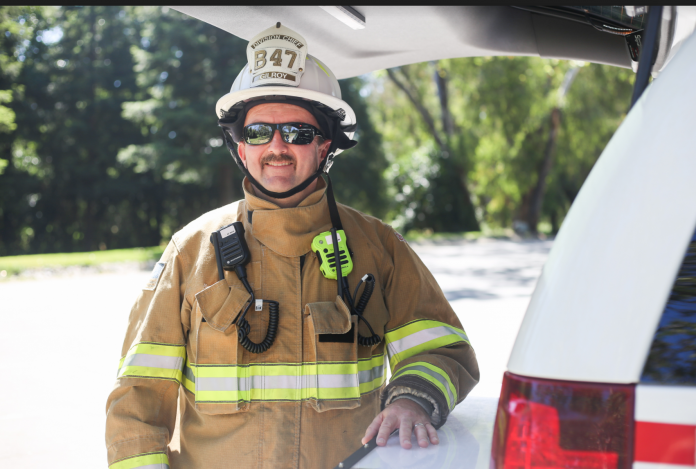When Colin Martin drives around Gilroy he sees, hears and feels things no one else in his family knows about.
They are called firefighter memorials.
It might be a corner where a woman died in a car crash, a house that once screamed with wailing after a teen suicide, or a store aisle where an old man left this life from heart failure.
When Martin says, “they are all over town,” firefighters know what he means.
Those private and often terrible memories are part of what Martin carries with him as he and his wife, Kelly a former county foster mother, embark on the next chapter of life–his retirement.
In June, the one-time grocery bagger retired from the Gilroy Fire Department after 32 years of service to the community he calls home, and a total of 35 years of quelled blazes, rescued disaster victims, chemical spills staunched, babies delivered, cats plucked from trees and medical care and comfort to the sick, injured, frightened and dying.
To say Martin will be missed seems wholly inadequate.
“Our fire department is better off today because of his contributions and his retirement creates a void which will be difficult to fill,” said Gilroy Fire Chief Alan Anderson, who learned a lot about the department’s history from the veteran Martin when he came aboard.
“His steadfast leadership has provided many of our members with a role model to emulate,” Anderson said.
Indeed, fellow firefighters describe their even-keeled friend as a compassionate man of deep faith and strong moral values who is devoutly active in the New Hope Community Church and is a smart, calm leader who treats others with respect, dignity and caring.
“Safety was always his number one priority; he made sure firefighters and civilians were safe and that everyone was going to go home after the shift,” said Greg Lopez of Hollister, an acting Gilroy fire captain and 15-year department veteran.
“He’s the kind of guy you definitely want on your side, the one you want to be in the trenches with,” said Shaun Peyghambary, of Gilroy, an acting division chief who stepped into Martin’s boots when his friend and colleague of 15 years retired.
Martin first waded into the smoke and singe of fire service as a paid-call firefighter in Morgan Hill.
That’s where his family had moved in 1965 from Bangor, Maine when he was kindergarten age. He played basketball and football at Live Oak High School and was graduated in 1980.
The young Martin then enrolled at Gavilan Community College, but by 1982 he was the married father of a baby boy and bagging groceries at Nob Hill Foods in Morgan Hill to make ends meet while managing a 16-unit apartment building for free rent.
He wanted something better for his young family and a firefighter friend suggested he try pulling on some big boots and a pair of suspenders and going along for a few rides. And that’s just what he did.
“I wanted to see if I liked it before I committed to (firefighter) school,” Martin said recently. “I loved it. I felt it was a way to get somewhere fairly quickly for my family.”
He did ride-alongs and spent nights at the Morgan Hill fire station so he could respond to late calls. At the same time he commuted to Mission College to study fire suppression and prevention.
And all the while he worked full time at Nob Hill Foods and managed the apartments. It’s a period of his life he remembers as one of “a lot of responsibilities.”
By 1984, he’d hired on with the Hollister Fire Department and a year later was offered jobs with the Gilroy and San Jose departments.
He picked Gilroy, because, “I am kind of a smaller town guy, it’s my nature,” said the father of two and stepfather of two.
He still heads east every November to visit family, hunt and spend time in his remote Maine cabin not too far from his sister’s home in the house his father, who worked in radio and TV, built.
Martin, soon to be 56, was with Gilroy through five chiefs and rose from firefighter to division chief, the second highest rank. On retirement he was the last person left who could boast he started when firefighters still stood on the tail boards of engines racing to blazes and communicated with the driver by horn–one blast meant stop, two meant go.
Today, everyone rides inside the cabs of trucks built for all occasions and crews are wired with communications devices that can send real time medical data via cyberspace to doctors waiting in hospitals for accident and medical emergency victims.
Martin also was one of the few left who could recall a Gilroy department with no paramedics, only two fire stations– the city is planning its fourth–and 21 employees, a number now at about 35.
Of the most significant changes, Martin said, one has been departments going from single-mission responders to multi-skilled, multi-tasking agencies with state-of-the-art vehicles and equipment, ones whose personnel put in a required 240 hours of training a year and do everything from fighting fires and water rescues to sophisticated arson investigations and hazardous chemical calls and are the city’s first medical responders.
Firefighter pay has undergone ladder-climbing changes, too.
When he started, Martin earned $24,000 a year, not counting benefits.
At retirement, he was pulling down more than $173,000 a year and had an annual benefits package worth $80,000–for a total compensation of more than $253,300 a year.
Pensions also are hot stuff these days compared to when Martin stepped on his first tailboard.
For his CalPERS retirement, after 32 years with the city, Martin’s pension is likely to be in the $140,000 a year range.
Another change in the fire service has been the explosion in calls, from about 500 in 1985 to 5,000 today, Martin said, the increase largely due to medical responses.
And with that increase came the heightened exposure over a career spanning decades to difficult situations and scenes, the kind that, due to the recognition of their potential mental health ramifications, nowadays can bring psychological counseling.
“I have driven past places and thought of a call that happened there and never mentioned anything to my wife,” Martin said.
“We are there to help fix problems but sometimes we can’t. We go back to our houses with the adrenalin and try to unwind or eat dinner and get ready for the next day. You just kind of suck it up (but) it’s cumulative.”
Martin recalled watching Gilroy paramedic/firefighters work furiously but ultimately without success to revive a man who had collapsed in his bedroom with a heart attack.
“I knew I had to take the long walk downstairs to a family in the living room and tell them what I had to tell them, and that is a very long walk,” Martin said. “It’s horrible to have to be the bearer of that news. I don’t forget those.”
But Martin, a very spiritual man, also has experienced the deep satisfaction and joy that come with the job, as when someone stops by the fire station to thank him and his colleagues, or when, as he put it, “I have held a new baby in my hands.”
All things considered, Martin said, “The career has been good, it has been great, and I would not trade it for anything.”















